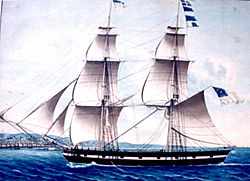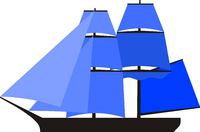Brig facts for kids
A brig is a type of sailing ship that has two masts. Both of these masts have special square-shaped sails.
During the time when sailing ships were common (called the Age of Sail), brigs were known for being fast and easy to steer. They were used for different jobs. Some brigs were naval warships, fighting battles at sea. Others were merchant vessels, carrying goods for trade. Even after steamships became popular, brigs were still used as training ships for sailors.
Brigs were smaller than many other two-masted sailing ships. They were very popular in the 1700s and early 1800s. However, when steamships arrived, brigs started to be used less. This was because they needed a lot of crew members for their size. Also, it was hard to sail them directly against the wind.
It's important not to confuse a brig with a brigantine. A brigantine has different sails. A brig has square sails on both masts, plus a small extra sail called a spanker on the back mast. A brigantine has square sails on its front mast, but a different type of sail (a gaff-rigged mainsail) on its back mast. A brig is also different from a three-masted ship because it only has two masts.
Contents
What Makes a Brig Special? (Rigging)
In sailing, a full-rigged brig has two masts. These are called the fore mast (front) and the main mast (back). Both masts carry square sails.
The main mast is the one at the back of the ship. To help the ship turn and steer better, the main mast also has a small fore-and-aft sail. This sail is called a gaff rigged spanker.
Brig sails are named after the mast they are on. On the main mast, you'd find the mainsail. Above that is the main topsail, and then the main topgallant sail. Sometimes, an even smaller sail called the royal is above those. Behind the mainsail, there's a small fore-and-aft sail called the spanker or boom mainsail. It's similar to the main sail on a schooner.
The foremast (front mast) is a bit smaller than the main mast. It holds the foresail, fore topsail, fore top gallant sail, and fore royal. Between the fore mast and the front of the ship (called the bowsprit), there are sails like the fore staysail, jib, and flying jib.
All these sails and their poles are controlled by a complex system of ropes. These ropes are called the running rigging. They are used to move the sails. Other ropes, called the standing rigging, are fixed in place. They help keep the masts and other parts of the ship strong and steady. Traditionally, running rigging was lighter in color because it wasn't coated with tar. Standing rigging was tarred to protect it from the weather, making it darker or even black.
The Ship's Body (Hull)
A brig was usually built bigger than a schooner. It could sometimes be almost as large as a full-sized, three-masted ship. Brigs were typically between 75 and 165 feet (23–50 meters) long. They could weigh up to 480 tons.
Historically, most brigs were made of wood. However, some later brigs were built with hulls (the body of the ship) and masts made of steel or iron. Brigs built with pine wood in the 19th century were designed to last about twenty years. Many of them actually lasted even longer!
Brigs in History
Brigs were used as small warships. They usually carried about 10 to 18 cannons. Because they were fast and easy to steer, they were popular with pirates. However, they were not very common among American and Caribbean pirates.
Brigs have been used since before the 17th century. But they were most famous during the 19th century. They took part in important naval battles, like the Battle of Lake Erie. In the early 1800s, the brig was a common cargo ship. People thought they were "fast and well sailing." But, as mentioned, they needed a large crew to handle all their sails.
While brigs couldn't sail directly into the wind as easily as fore-and-aft–rigged ships like schooners, a skilled brig captain could "manoeuvre it with ease and elegance." A brig could even "turn around almost on the spot." Brigs also had an advantage over fore-and-aft rigged ships when sailing in the open ocean. This was especially true when sailing with the wind for long distances. On other ships, a sudden change in wind direction (a "jibe") could be very dangerous. This led to the development of the barquentine, which combined features of both types of ships.
The need for many crew members for their size led to fewer brigs being built. They were replaced in trade by gaff sail schooners, which needed smaller crews. Steamships also took over, as they didn't have problems sailing against the wind like square-rigged ships did.
The Telos, built in Bangor, Maine in 1883, was said to be the last brig to join the American merchant fleet. It was considered "the finest vessel of her class ever constructed in Maine." Sadly, it was wrecked near Aves Island, off Bonaire in the Caribbean, in 1900.
Images for kids
-
The South Shields collier brig Mary, painted in 1855. It shows two views of the same ship.
-
The snow brig Niagara.
-
Rimac, a brig built in Whitehaven in 1834 for trade between Peru and Liverpool.
-
A painting of the brig USS Niagara during the 1813 Battle of Lake Erie.
-
Brig "Mercury" Attacked by Two Turkish Ships, painted by Ivan Aivazovsky in 1892.
-
The brig Lady Washington.











